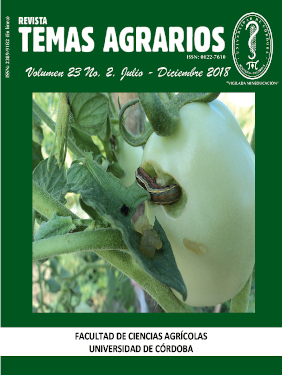Nutritional diagnosis of crops Tahiti acid lime [Citrus latifolia (Yu Tanaka) Tanaka] in Tolima (Colombia)
Diagnostico nutricional del cultivo de la lima ácida Tahití [Citrus latifolia (Yu Tanaka) Tanaka] en el departamento del Tolima (Colombia)
How to Cite
Rodríguez Polanco, E., Gutiérrez Díaz, J. S., & Orduz Rodríguez, J. O. (2018). Nutritional diagnosis of crops Tahiti acid lime [Citrus latifolia (Yu Tanaka) Tanaka] in Tolima (Colombia). Sour Topics, 23(2), 144-153. https://doi.org/10.21897/rta.v23i2.1298
Dimensions
license

This work is licensed under a Creative Commons Attribution-NonCommercial 4.0 International License.
Show authors biography
Article visits 1897 | PDF visits
Downloads
Download data is not yet available.
- Broadley, M., Brown, P., Calmal, I., Rengel, Z. y Zhao, F. 2012. Function of nutrients: micronutrients. En:Marshner, P. Marschner’s Mineral Nutrition of Higher Plants. Terceraedición. University of Adelaide. Australia. 191- 248 p.
- Broadley, M. y White, P. 2010. Eats roots and leaves. Can edible horticultural crops address dietary calcium, magnesium and potassium deficiencies? Proc Nutr Soc 69, 601–612. https://doi.org/10.1017/S0029665110001588
- Castro, H y Gómez, M. 2010. Fertilidad de suelos y fertilizantes. En: Ciencia del suelo Principios básicos. Sociedad Colombiana de la Ciencia del Suelo. 217- 298pp.
- Cohen, A. 1983. Fertilización de los cítricos. Inter. Potasa Institute. Bull. (4): 12-18
- Contreras, E., Almaguer, G., Espinoza, J., Maldonado, R. y Álvarez, E. 2007. Distribución de materia seca y nutrimentos en árboles de limón persa (Citrus latifolia Tan.) en Veracruz, México. Revista Chapingo. Serie Horticultura. 13(1), 77- 85.
- Corporación Universitaria Lasallista (Ed.). 2012. Cítricos: Cultivo, Poscosecha e Industrialización. Serie Lasallista Investigación y Ciencia. Artes y Letras S.A.S. Itagüí, Colombia. 367 p.
- Davies, F. y Albrigo, L. 1994. Citrus. CAB International, Wallingford, U.K. 254 p.
- DANE. Departamento Administrativo Nacional de Estadística 2016. Encuesta Nacional Agropecuaria-ENA. Disponible en:https://www.dane.gov.co/index.php/estadisticas-por-ena/agropecuario/encuesta-nacional-agropecuaria-ena. Consulta 30 de marzo 2018
- Donkersley, P., Silva, F. W., Carvalho, C. M., Al-Sadi, A. M., & Elliot, S. L. 2018. Biological, environmental and socioeconomic threats to citrus lime production. Journal of Plant Diseases and Protection, 1-18.
- Etchevers B. 1987. Diagnóstico visual. Centro de edafología. Colegio de Postgraduados. Chapingo, Estado de México.
- Gómez, M. 2005. Análisis de suelos como herramienta de diagnóstico en la evaluación química de la fertilidad en el cultivo de papa. En: Fisiología y nutrición vegetal en el cultivo de papa. Presente y futuro de la investigación en la cadena agroalimentaria de la papa en Colombia. CEVIPAPA. Bogotá, Colombia. 99p.
- Jackson, L. K. 1999. Citrus cultivation. Citrus Health Management. Timmer, LW and LW Duncan. (eds.) pp, 21-46.
- Jones, B., Wolf, B. and H. A. Mills. 1991. Plant analysis handbook: a practical sampling, preparation, analysis, and interpretation guide. Micro-Macro Publishing. Athens, GA, USA.
- Levy Y, Syvertsen J. 2004. Irrigation water quality and salinity effects in citrus trees. Hortic Rev 30:37–82
- Lucena, J. 1997. Methods of diagnosis of mineral nutrition of plant a critical review. Acta Hortic. 448, 179-192p. https://doi.org/10.17660/ActaHortic.1997.448.28
- Malavolta, E. 1995. Nutrición y fertilización de los cítricos. Fertilización de cultivos de clima medio. 2ª edición. Monómeros Colombo-Venezolanos, Bogotá, 133-169.
- Mattos, D., Milaneze, T., Alves, F. y Quaggio, J. 2010. Soil nutrient availability and its impact on fruit quality of Tahiti acid lime. Rev. Bras. Frutic. Jaboticabal. 32(1), 335- 342. https://doi.org/10.1590/S0100-29452010005000032
- Montañés, L., Heras, L. y Sanz, M. 1991. Desviación del Óptimo Porcentual (DOP): Nuevo índice para la interpretación del análisis vegetal. An. Aula Dei. 20(3-4) 93- 107.https://doi. org/10.1080/01904169309364613
- Montañés, L., Heras, L., Abadía, J. y Sanz, M. 1993. Plant analysis interpretation based on a new index: Deviation from optimum percentage (DOP). J. Plant Nutr. 16, 1289- 1308
- Ministerio de Agricultura y Desarrollo Rural, 2017. Evaluaciones Agropecuarias Municipales-EVA
- Orduz Rodríguez, J., León, G. y Arango, L. 2009. Lima Ácida Tahiti: Opción agrícola para los Llanos Orientales de Colombia. Corpoica, Issue 53, p. 5.
- Orduz-Rodriguez, J. 1998. Características de la citricultura en el departamento del Meta y avances en el proceso de desarrollo tecnológico. En: Actualización tecnológica en ajonjolí, caucho, hortalizas y frutales para la Orinoquía colombiana. Corpoica. Villavicencio,
- Quiroga, J., Hernández, F., Silva, M. y Orduz-Rodriguez, J. 2010. Comportamiento de la producción de lima Tahití (Citrus latifolia Tanaka), injertada sobre el patrón de mandarina Cleopatra (Citrus reticulata Blanco) y la influencia del virus de la tristeza (CTV) en condiciones del piedemonte del Meta, 1997-2008. Orinoquia. 14(1) 1-11.
- Robson, A. y Reuter, D. 1981. Diagnosis of copper deficiency and toxicity. En: J. F. Loneragan, A. D. Robson and R. D. Graham (Eds.). Copper in Soils and Plants. Academic Press, London and Orlando. 287–312 pp.
- Saha, L. 2002. Hand book of plant diseases. Kalyani Publishers, Ludhiana, pp 290–292.
- Srivastava, J., Sharma, P., Dutta, U., Srivastava, A. y Kumar, R. 2015.Nutritional disorders of citrus and their management. En: Awashti, L. (Ed.). Recent advances in ths diagnosis and management of plant diseases. Springer. India. 285- 294. https://doi.org/10.1007/978-81-322-2571-3_21
- Szucs, H. 1997. Possibilities to meet nutritional requirements of fruit trees and environmental protection. Acta Horticulture. 448, 433-436. https://doi.org/10.17660/ActaHortic.1997.448.80
- Tang, N., Li, Y. y Chen, Li. 2012. Magnesium deficiency–induced impairment of photosynthesis in leaves of fruiting Citrus reticulata trees accompanied by up-regulation of antioxidant metabolism to avoid photo-oxidative damage. J. Plant. Nutr. Sci. 175, 784-793. https://doi.org/10.1002/jpln.201100329
- Ventura, F., Salgado, S., Castelán, M., Palma, D., Rivera, M. y Sánchez, P. 2012. Métodos de interpretación del análisis nutrimental en naranja valencia (Citrus sinensis L. Osbeck). Terra Latinoamericana. 30(2), 139- 145.
- Walworth, J. y Sumner, M. 1987. The diagnosis and recommendation integrated system (DRIS). Advances in Soil Science. 6, 149-188. https://doi.org/10.1007/978-1-4612-4682-4_4
- Yang, L., Yang, G., You, X., Zhou, C., Lu, Y. y Chen, L. 2013. Magnesium deficiency-induced changes in organic acid metabolism of Citrus sinensis roots and leaves. Biology Plantarum 57(3), 481- 486. https://doi.org/10.1007/s10535-013-0313-5




















